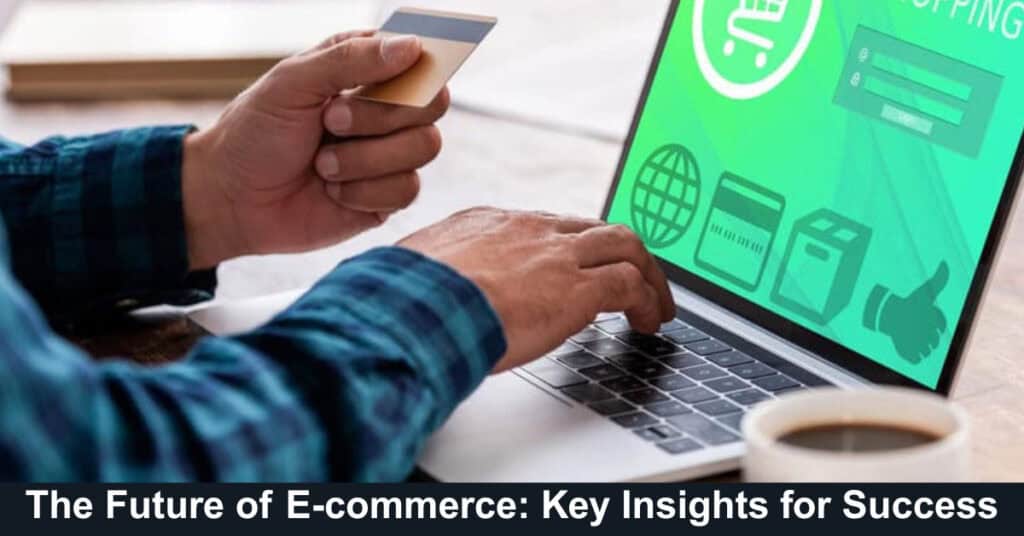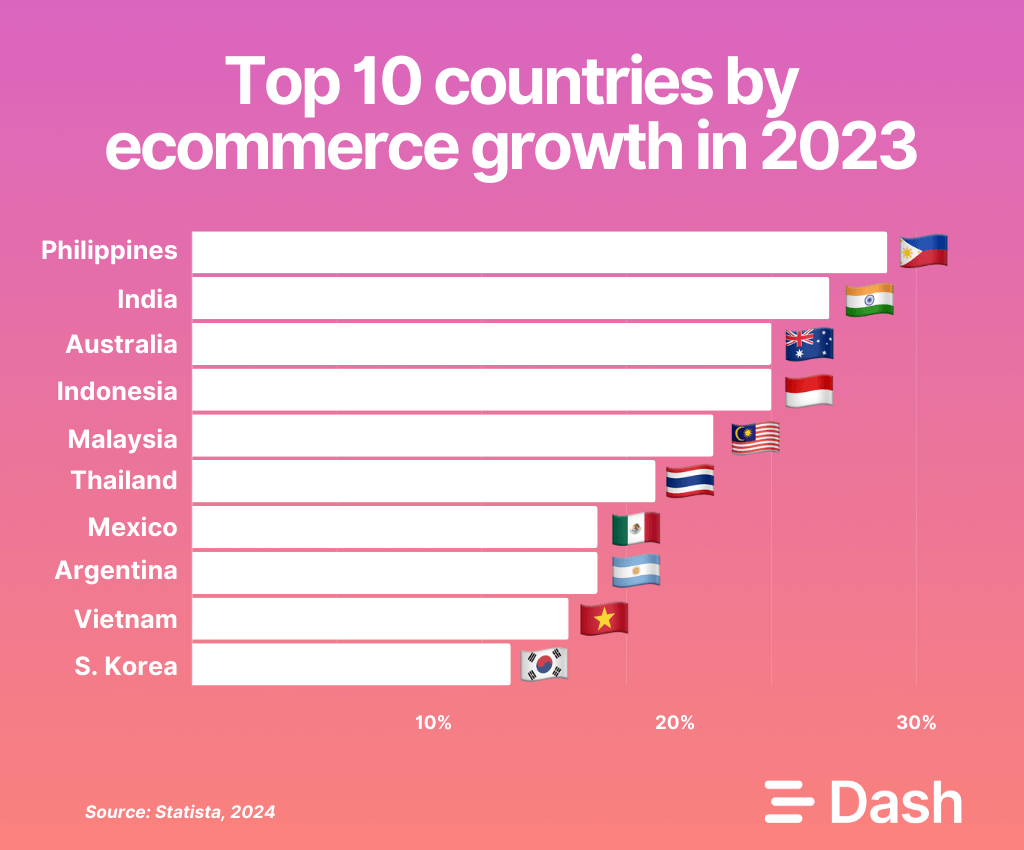
From the first newsletters to full-scale advertising campaigns, e-commerce marketing has come a long way. With the introduction of artificial intelligence and machine learning, sales increased by an average of 35%. Since 2021, agencies and companies have been opening exclusively specialized in e-commerce activities.
According to Forbes, in just 25 years, e-commerce has generated more than $2 trillion in global sales. By 2024, the market is projected to reach $6.3 trillion with a CAGR of 8.8%, accounting for 20.1% of all retail purchases. By 2027, the e-commerce market is expected to exceed $7.9 trillion, with online shopping making up 23% of total retail sales.
By effectively leveraging emerging trends and applying the right expertise, businesses can significantly boost their e-commerce sales. This article explores practical strategies for transforming market trends into sustainable profits.

Easy Navigation and Quick Product Search
The first interaction visitors have with a website is its navigation. Studies show that over 80% of shoppers leave a site before completing a purchase, often due to confusing layouts, unclear menus, or poorly structured site maps. A seamless and intuitive navigation system is therefore essential to keeping customers engaged and guiding them toward conversion.
Industry research highlights that 54% of marketers consider ad clutter the biggest barrier to a positive user experience. Among dissatisfied users, 91% exit without leaving feedback, while 13% share their negative experiences with an average of 15 people. On top of that, 88% of online shoppers are unlikely to return after a poor experience, and 89% will choose a competitor instead. These numbers emphasize the importance of clear navigation, quick product search, and mobile-friendly design.
Even modest investments in usability can deliver significant returns. Companies that spend between $2,000 and $2,500 on website design often see up to $15,000 in return. In other words, improving website navigation and user experience is like turning a $1 investment into $100—an opportunity to boost customer satisfaction, loyalty, and long-term profitability. Measuring the impact through incrementality testing can help businesses understand which design changes truly drive additional conversions and long-term value.
Personalized Product Recommendations
Personalized recommendations are centered around data, and tailored suggestions are made to online customers based on their browsing history, previous purchases, and interests. For example, if a customer routinely buys running shoes, the e-commerce platform can promote comparable athletic gear, resulting in a more customized shopping experience.
For the past five years, personifying product recommendations via mobile applications has been a classic e-commerce practice. This approach has proven particularly effective in specialized markets, where businesses like beBOLD Digital – Amazon Premium Beauty Growth Partner leverage sophisticated recommendation algorithms to help beauty brands connect with their ideal customers through targeted product suggestions and strategic marketplace positioning. There have been several types of recommendations:
- Seamless In-App Recommendations. This tool displays products that match a user’s previous preferences directly on the home or category screen.
- Targeted Push Notifications. These notifications suggest products or offers that are in line with the user’s interests and past activity.
- Engaging Interactivity. Attract more prospects and build trust with new customers by visualizing statistics, such as product quality surveys.
The combination of these types increases the variability of sales and reduces the spamming of the user’s feed. Overcode, which develops mobile applications and platforms for SignifAI and Hydrolix, uses personalized recommendations to reach a wider audience and promote its products.
Convenient and Secure Payment Methods
While online payments are fast and convenient, they also present significant security concerns for both businesses and consumers. Without proper safeguards, sensitive data such as credit card details and account credentials can be exposed to unauthorized access. According to Statista, global spending on cybersecurity is expected to surpass $80 billion in 2023 and is projected to exceed $87 billion by 2024.
Trusted payment solutions such as PayPal, Stripe, and Square have become industry standards due to their reliability, robust security features, and seamless integration. For any e-commerce web design company, adopting these secure payment methods is essential—not only to enhance customer trust and satisfaction but also to streamline business operations and ensure long-term growth.
Push Notifications and Personalized Promotions
One of the key features of e-commerce marketing today is push notifications. Reminders of some event or another (product promotions, drawing or availability of bonuses, subscription expiration, and so on) serve to communicate between the company and the customer. Push notifications can easily expand your business opportunities, regardless of your company’s size or customer base. With your push notifications, your subscribers can be directed to:
- A Shopping Cart With Outstanding Products: A simple reminder about abandoned items can push customers to complete a purchase they were already considering, reducing cart abandonment and increasing conversions.
- A Content Update (Blog Post, Podcast, or Video): Notifications that point customers toward fresh content keep them engaged with your brand beyond just shopping, building loyalty through value-driven interactions.
- Information About a New Product Release or Update: Announcing new arrivals or upgrades directly to your audience ensures they are the first to know, creating excitement and urgency around your launch.
- Surveys and Questionnaires: Inviting customers to share feedback not only gives you valuable data for improvement but also makes them feel included and valued in your brand’s growth.
Promotions have evolved beyond traditional push notifications. Once limited in scope and tied to specific platforms, they now extend across multiple channels, creating a more seamless and impactful customer experience. With the rise of Artificial Intelligence, businesses are increasingly focused on delivering hyper-personalized interactions. This includes offering dynamic pricing, launching tailored promotions, and even designing adaptive web interfaces that respond to individual customer preferences and behaviors.
Easy Returns and Order Tracking
Order management is one of the most complex and demanding aspects of running a business. Balancing inventory, meeting customer demand, and maintaining satisfaction can quickly become overwhelming without the right systems in place. What was once considered a simple customer convenience—order tracking—has now evolved into a critical business necessity. Modern order management tools not only provide transparency for customers but also enhance operational efficiency, improve accuracy, and strengthen overall performance.
In e-commerce, from when an order is placed to when it is delivered, order tracking is essential for providing customers with visibility into the status of their purchases. Customers can track their orders online to know when their package will arrive and where it is in the shipping process using tracking numbers or order IDs. To manage inventory, process orders efficiently, and coordinate delivery logistics, e-commerce platforms and logistics companies use order tracking systems.
Final Thoughts: Back To The E-Commerce Future
What does the future of business hold? From an e-commerce perspective, the focus will increasingly be on enhancing the user experience to make product discovery seamless and engaging. The development of mobile applications is expected to accelerate, with more than 50 new apps projected to launch daily by January 2024. According to Mindsea, mobile devices already account for 59.7% of global website traffic, compared to just 38.2% from desktops.
Looking ahead, push notifications will become more sophisticated, integrating personalized offers and working in tandem with email newsletters to deliver a more tailored customer experience. At the same time, tracking systems with flexible UX/UI configurations will continue to evolve, prioritizing stronger cybersecurity measures and greater transactional anonymity.
Suggested articles:
- How Small E-Commerce Stores Can Avoid Hosting Bottlenecks During Peak Traffic
- Benefits of Outsourcing for E-commerce
- 10 Best Tech Solutions for Your E-Commerce Startup
Daniel Raymond, a project manager with over 20 years of experience, is the former CEO of a successful software company called Websystems. With a strong background in managing complex projects, he applied his expertise to develop AceProject.com and Bridge24.com, innovative project management tools designed to streamline processes and improve productivity. Throughout his career, Daniel has consistently demonstrated a commitment to excellence and a passion for empowering teams to achieve their goals.